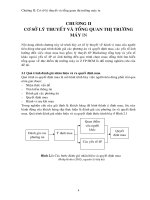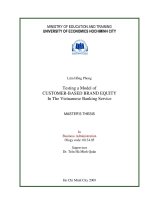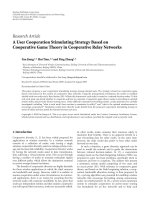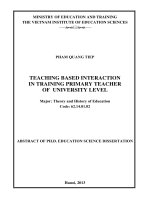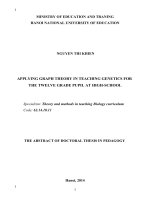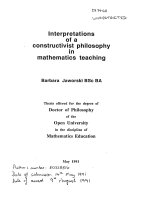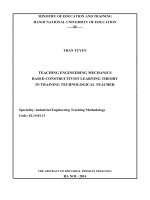Teaching Engineering Mechanics based constructivist theory in training technological teacher = Dạy học Cơ kỹ thuật theo lý thuyết học tập kiến tạo trong đào tạo giáo viên Công nghệ (tóm tắt + toàn văn)
Bạn đang xem bản rút gọn của tài liệu. Xem và tải ngay bản đầy đủ của tài liệu tại đây (399.58 KB, 25 trang )
MINISTRY OF EDUCATION AND TRAINING
HANOI NATIONAL UNIVERSITY OF EDUCATION
TRAN TUYEN
TEACHING ENGINEERING MECHANICS
BASED CONSTRUCTIVIST LEARNING THEORY
IN TRAINING TECHNOLOGICAL TEACHER
Speciality: Industrial Engineering Teaching Methodology
Code: 62.14.01.11
THE ABSTRACT OF DOCTORAL THESIS IN PEDAGOGY
Ha Noi - 2014
INTRODUCTION
1. Reasons for choosing the topic
Education must promote learner’s proactiveness, positive, creativeness in
accordance with the characteristics of each class and each subject. It must create
a proactive environment for students to acquire and master knowledge based on
their own understanding in which teaching methods emphasize on self-
studying, skills to apply knowledge in practice, impacts on movement and
creating joy to learners.
Teaching the methods to acquire knowledge is an important prerequisite
step nowadays. Students should be taught how to tackle issues by
constructivism of knowledge so that they have skills in modern life. Student’s
capacity of constructing new knowledge needs to be formed when they are
sitting in school.
Practice reveals that teaching method innovations in schools are now
undertaken quite slowly. Therefore pedagogical students should be equipped
new knowledge about teaching methods to apply in reality after graduation in
accordance with the policy of the Communist Party and State.
Teaching based constructivist theory is an approach to active teaching
methods. Teacher does not impart available knowledge or provide the truth, but
to orient, direct students to discover the truth, find out knowledge by
themselves.
2. Purposes of the research
To propose teaching methods to Engineering Mechanics in pedagogical
college Training programs based constructivist knowledge theory to teach
students knowledge and methods to occupy such knowledge (research
methodology) which enables them the ability of lifelong learning.
3. Object and Subjects of research
3.1. Object of research
The process of teaching Engineering Mechanics for Technology majored
students of Pedagogical college
3.2. Subjects of research
2
- Ability to apply constructivist learning theory in teaching and apply to
the Engineering Mechanics subject.
Teaching methods for Engineering Mechanics subject based on
constructivist learning theory.
3.3. Scope of research
Research topic focuses on studying constructivist learning theory and
application in teaching mechanical technical subject in Technology teacher
training programs at college.
4. Scientific assumption
If teaching methods for technical engineering subject and proposals are
applied appropriately (in pedagogical college training programs) according to
study tectonic theory will be taught to students not only master the knowledge
that both methods occupy (research methodology) knowledge that enables them
to potentially life-long learning.
5. Tasks of research
5.1. Form a theoretical basis for studying constructivist learning theory and
applications in teaching in general and in teaching Engineering Mechanics in
Technology teacher training programs at secondary school.
5.2. Learn about the reality of teaching Engineering Mechanics in
pedagogical colleges on the standpoint of constructivist learning theory.
5.3. Conduct logic analysis of technical engineering knowledge in
secondary teacher training program as a basis for teaching the subject based
constructivist learning theory; create learning process based constructivist
learning theory for Engineering Mechanics.
5.4. Test and evaluate Engineering Mechanics teaching based
constructivist learning theory to verify hypotheses of topic.
6. Research methods
Using the following dual system of research methods:
6.1. Group of theory research methods: systematization, analysis,
synthesis, comparison of relating theorical teaching materials, particularly
constructivist learning documents. Based on those to develop a theoretical basis
3
for the application in teaching Engineering Mechanics based constructivist
learning theory for Technology teacher training program.
6.2. Group of practical research methods:
6.2.1. Basic survey method: investigate the reality of teaching Engineering
Mechanics in pedagogical colleges based standpoint of constructivist learning
theory.
6.2.2. Expert method: consult experts on applying constructivist learning
theory in teaching Engineering Mechanics in the Technology teacher training
program at pedagogical colleges.
6.2.3. Experiment Method: conduct pedagogical experiment to verify
scientific hypotheses.
6.2.4. Observation method: Observe the learning activities of students to
have recommendation, practical evaluation about constructivist learning theory
application.
6.2.5. Statistic method: Use cases for statistical calculation and indicate
results in quantitative manner.
7. Contribution of the thesis
7.1. Develop constructivist learning theory in teaching Engineering
Mechanics at pedagogical college.
7.2. Propose teaching principles and learning process of constructivist
learning theory in teaching Engineering Mechanics at pedagogical college.
7.3. Propose three measures (with experiment) to apply constructivist
learning theory in teaching Engineering Mechanics
8. Structure of the thesis
Besides the introduction, conclusion and appendix, the thesis includes 3
chapters:
Chapter 1: Theoretical and practical basics of teaching Engineering
Mechanics based constructivist learning theory.
Chapter 2: Teaching methods for Engineering Mechanics based
constructivist learning theory.
Chapter 3: Testing and evaluation
4
Chapter 1: THEORETICAL AND PRACTICAL BASICS OF
TEACHING BASED CONSTRUCTIVIST THEORY
1.1. Historical overview of research
Jean Piaget, John Dewey, Vugotski, Glaserfeld were the first founders of
constructivist learning theory. This theory has been studied and applied in
teaching based on the following viewpoints:
- Knowledge is constructed in a positive way by subject of perception
rather than passively absorbing from the outside environment.
- Learners’ perception is an organization and an adaptive process of their
own knowledge.
- Perception is not to discover a world for humanity but the process to find
new things for the individuals that they are not aware of.
- Learning is a social process in which learners gradually immerse
themselves in intellectual activities of those around them.
Brandt, Douglas H. Clementes, Michael T. Battista, Ernt Von Glaserfeld
were the next generations who developed research and applied constructivist
learning theory in teaching with points of view:
- Knowledge is actively discovered by learners, not passively received
from others or environment.
- Learners should create new knowledge for themselves through physical
and intellectual activities.
- Manners of expressing the world of and understanding of scientific
knowledge is personalized by each learner.
- Learning is a social activity in which students gradually immerse in the
intellectual activity of those around them.
- Knowledge is constructed individually through operation methods of
each individual.
Knowledge is the result of tectonic activity of subject of perception, not the
product by this way or another externally exists to subject of perception and can
be conveyed or instilled by frequent cognitive activities or communication.
5
Pioneers in tectonic studies initially show application of constructivist
learning theory in classes. Learners not only involve in the process of
discovering, inventing, but also participate in all social processes, including the
interpretation of exchange, negotiation and evaluation. They acquire new
knowledge from adjusting their world outlook to meet requirements set by
natural and social reality.
Many countries around the world have been implementing constructivist
learning theory pattern in which learners master their learning. Learners are
guided, encouraged to stay independently and implement plans of their own
learning. The teacher is a guide who is not arbitrary but reliable and provides
supervision of student activities. The fact reveals that these countries have
gained certain achievements in education that many countries, including our
country should follow.
In our country there are typical authors such as Nguyen Huu Chau, Thai
Duy Tuyen, Do Tien Dat, Tam Dao, Nguyen Quang Lac, Bui Phuong Nga,
These authors have learnt history of tectonic teaching and summarized the basic
characteristics of theory application to teaching. Although the theory has not
been widely deployed, authors’ work in Vietnam in recent years have shown
that the process of education reform in our country has got strong response
from pedagogical colleges, particularly active teaching methods in teaching
which initially apply constructivist learning theory to teaching.
Some authors have studied constructivist learning theory applying in
teaching specific subjects. It's innovative teaching research in the Chemistry,
Biology, Mathematics and Physics. The work shows that authors have initially
launched a teaching process based on standpoint of constructivist teaching;
proposed specific examples of teaching; conducted strengths and weaknesses
analysis when applying constructivist learning theory; initially applied
constructivist teaching processes in several specific contents. The research
constructivist learning theory has partly contributed positively to the innovation
of teaching methods enhanced the quality of teaching and learning.
6
Improving the quality of teaching methods towards innovation has been
extensively researched in terms of both basic theory and applicability in each
specific content. Constructivist learning theory appeared long ago in the world
which has been specified by the efficiency of educational training of some
countries and currently draws much interest in Vietnam. Therefore, research
trends and application of constructivist learning theory in teacher training
programs are feasible and meet renewal requirements of higher education.
1.2. Some fundamental concepts related to teaching based on
constructivist learning theory
1.2.1. Constructivism
Constructivism is of human activity based on his ability to conquer the world
around individual become a skill. Thanks to this ability of human that we are on
the way to conquer the scientific knowledge. The fact reveals that one day that
human being is at grade 1 but soon becomes a university student.
In teaching, constructivism is considered as the theory of which its pattern
is the biological basis of mind to explain the mechanism of learning. The
fundamental idea of constructivist learning theory is to take the role of
perceiving subject to the leading position of cognitive processes. Reality shows
that each individual forms their own world outlook. Everything that each
experienced would be arranged into "panorama of the world" of the person, that
is to construct their own picture of the world.
1.2.2. Constructivist learning
Learners acquire knowledge expressed in the following forms:
- Individual constructivism or self-study
- Constructivist learning through teacher or in cooperation of friends
- Constructivist learning from feedback or self-examination, self-
adjustment
Constructivist learning is of learner’s activity which takes place in the
activity of the perceiving subject. Learners build their own knowledge on the
basis of the inherent knowledge and interaction with the environment to correct
or expand their own knowledge.
7
1.2.3. Assimilation
Assimilation is that subject re-establish some of the characteristics of the
perceived object, puts them into the available diagram. The term assimilation
describes change in individual perception or groups as a result of from old
perception of the continuous social interaction among members
Assimilation occurs as a mechanism to preserve what has been known in
memory and allows learners to solve new situations based on familiar concepts.
The process of assimilation is the process in which subject receives object, that
is the subject uses available knowledge and skill to process information and
external impacts to achieve awareness goal.
1.2.4. Accommodation
Accommodation means to adjust, adapt, and change in accordance with special
purposes. It is a process in which subject adapts to diverse environment
requirements by re-establishing available characteristics of object, thereby altering
available structure, create a new structure, leading to equilibrium.
Accommodation occurs when the learner fails to apply familiar knowledge and
skills to solve new situations. Thus, to tackle this situation learners need to change,
adjust and even discard existing knowledge and experience. When a new situation
is resolved, new knowledge is achieved and added to the existing knowledge
system.
1.3. Constructivist learning theory and application
1.3.1. Over view of constructivist learning theory
In learning, thinking process takes place to create the transformation within
learners’ cognitive processes. In essence, the process of "assimilation" and the
"adaptive adjustment" about understanding is to use "experience" and change
"experience" of acquired knowledge.
Constructivist learning theory emphasizes knowledge students have
learned in previous grades or lessons which is call basic constructivist learning.
Constructivist learning theory which promotes the interaction between learner’s
existing knowledge and environment in their learning process is also known as
social constructivism.
8
Figure 1.1: Diagram the process of assimilation and application of learning
1.3.2. Basic constructivism
Basic constructivism enhances the role of each individual in the cognitive
process and how individuals construct knowledge for themselves.
Constructivism focuses on basic metabolic processes within the individual's
cognitive process. Basic constructivism respects learners’ experience in process
of forming their own scientific world outlook. Emphasis on basic
constructivism in teaching is the emphasis on the active role of learners as well
as the isolation of learners’ perception.
Advantages of basic constructivism are to confirm the active role of
learners in cognitive process. Learning organization with basic constructivism
orientation will facilitate learners to construct their own knowledge; learners
should become the owner of that knowledge.
If basic constructivism is overvalued, learners will be placed in isolation
and construction of knowledge shall lack social factor. Therefore, in teaching,
in addition to exploiting the strengths of basic constructivism, teachers should
combine with social constructivism to ensure higher efficiency of teaching
process.
1.3.3. Social constructivism
Teaching organization with social constructivism orientation is to
emphasize social objective knowledge. Human beings explore the world and
construct intellectual treasure. Knowledge is the product of humans and is
9
constructed both socially and culturally. Each individual makes it meaningful
through interaction with others and with the environment in which they live.
Social constructivism regards learning as a social process; constructivist
learning is not a process that only takes place in the human mind, not a passive
development of human behaviour, but is formed by the external impact.
Learning is only meaningful when individuals are attracted to the social
activities.
1.3.4. The structure of teaching based constructivist learning theory
Applying constructivist learning theory to teaching is so-called
constructivist teaching and is reflected in organization of specific subjects.
Therefore understanding the structure of teaching based constructivist learning
theory makes great sense in organizing to teach specific subjects. The structure
of teaching based constructivist learning theory is the interaction or relationship
of mutual interaction between basic components: teacher, learner, content with
the core of activities is experience of learner that takes place in a positive
learning environment.
Learning environment in constructivist learning theory is the place in
which teacher organizes so that learner can use the "experience" to learn the
lesson content. Teaching environment is considered extremely important factor
in teaching based constructivist learning theory. Except for social nature
teaching facilities are also considered the environment impacting study. Learner
can work independently as well as support each other in using a variety of tools
and resources to jointly pursue academic goals with the help from teacher.
Creating a friendly environment for learning is an important task in teaching
based constructivist learning theory. Interaction among learners will be more
effective when it occurs in a positive and democratic learning environment.
Experience is the knowledge that learner has accumulated through
academic or practical experience.
Learner is perceiving subject and goals as well as learning outcomes of
teaching based constructivist learning theory.
10
Teacher is the person who supports and promotes activities to take place in
a classroom environment.
Nội dung dạy học theo lý thuyết học tập kiến tạo không chỉ là nội dung của
bài học mà người học cần tiếp thu mà còn là những kiến thức có liên quan đến
kinh nghiệm của người học.
1.3.5. Applying Constructivist learning theory in teaching
Constructivist learning theory considers learner as both object and subject
of teaching process. This idea is applied in teaching through specific teaching
methods such as problem-solving method, research methods, Algorit method,
These active teaching methods share a common feature that is to create the best
environment for learners to use experience to research content. However,
depending on specific academic content that teacher selects rational approach
for learners to learn constructivist learning theory.
1.4. Current status of teaching Engineering Mechanics based on
constructivist view
Investigation of initial state to provide a general practice insight on
teaching Engineering Mechanics based constructivist learning theory, and the
ability to apply constructivist learning theory in teaching. That reflection in the
organization of the teaching has following characteristics: proactive learner,
positive learning activities; democratic learning environment; learner is a centre
of teaching activities; lecturer encourages student’s self-awareness and
responsibility in learning. The survey also aims to find out: what are advantages
and drawbacks when teacher applies constructivist learning theory in teaching
in class time? Are learner’s ability and needs consistent with constructivist
learning theory? Are teaching methods used by teachers consistent with
constructivist learning theory? What are means of support for teachers in
organizing learning based constructivist learning theory?
11
Chapter 2: TEACHING METHODS FOR ENGINEERING
MECHANICS BASED CONSTRUCTIVIST LEARNING THEORY
2.1. The introduction of Engineering Mechanics in pedagogical college
2.1.1. Course Objectives
Learners understand and use mechanical contents and identify Engineering
Mechanics problems, do mechanical exercises, contact, apply in reality.
Learners get more confidence in calculating and applying mechanical exercises
in practice.
Content of the subject is to solve the problem which is to apply in machine
in reality to design tool machines.
2.1.2. Analysis of the structure of Engineering Mechanics
Characteristics of the subject facilitate the application of learning theory to
teaching. These characteristics are specific, abstract, both abstract and specific,
integration, interoperability, inheritance, multi-function, multi-option,
applicability - practice
Engineering Mechanics teaching process needs to consider the knowledge
components:
- Knowledge of Mathematics (M) helps resolve calculation in most content
of Engineering Mechanics.
- Knowledge of Physics (P) is employed in Engineering Mechanics
including basic principles of movement, stand, physical nature of material,
object.
- Knowledge of strength of material, chemical used in Engineering
Mechanics relate to features, strength of detail, objects.
Thus teaching Engineering Mechanics needs to remind student’s
knowledge they have learned so that they can solve problems by their existing
knowledge. When they have learned the basic movements of a solid, using M
tools to synthesize movements will create a new movement; Engineering
Mechanics will help identify new movement in a more realistic way and
clearer. The movements that are synthesized calculated and described by M
equation is in fact real meaningful. With knowledge learned in P, students are
12
able to understand technical principles corresponding in the machine and
understand operation of details. By organizing appropriate learning activities,
conducting appropriate research methods, along with the M supportive tools
and other basic sciences, students fully learn Engineering Mechanics which
corresponds to logic design and construction of the machine. Study basic
movements and actual structure will stimulate students solve real life tasks
techniques and create Engineering Mechanics knowledge.
2.1.3. Ability to apply constructivist learning theory in teaching
Engineering Mechanics
Engineering Mechanics has “close" content and uses "materials" from the
basic sciences such as P and M. Therefore, when applying to constructivist
teaching it should be based on starting point knowledge of students to organize
learning. The knowledge students have learned in P and M will be very useful
for constructivism of new knowledge. Abstract and practical universe of the
subject will suit curious psychology of students which will facilitate students to
use existing knowledge to construct new knowledge, learn applications and
solve problems arising in their minds. The subject characteristics also
contribute to the develop intellectual capacity such as analysis, synthesis,
abstraction, generalization, and cultivation of virtue, the qualities of the
workers such as carefulness, accuracy count discipline, critical thinking,
creativeness, aesthetic sense. These features will create conditions for students
to mobilize and operate their learning "engine" in knowledge discovering
process, skill formation which is convenient to organize individual activities
and group in constructivist learning.
2.2. Principles in teaching Engineering Mechanics based constructivist
learning theory
Principle 1: Teaching Engineering Mechanics based constructivist learning
theory must reach two main goals, it is important to teach knowledge and
teaching methods to dominate knowledge (research methods). It is to teach
students research methods through teaching Engineering Mechanics knowledge.
13
Principle 2: Engineering Mechanics is considered the basis subject of
engineering. Therefore Engineering Mechanics based constructivist learning
theory has to regularly relate to practice and technical expertise so that students
relate knowledge in Engineering Mechanics with fields using this kind of
knowledge.
Principle 3: In the teaching process it is necessary to increase level of self-
study to occupy knowledge by organizing different forms of teaching such as
seminars, group study, research assignments,
2.3. Process in teaching Engineering Mechanics based constructivist
learning theory
Based on assimilation and adaptive adjustment diagram in constructivist
learning theory, Engineering Mechanics teaching process must be carried out in
accordance with constructivist learning process such as the following diagram:
Figure 2.1: Diagram constructivist learning process
Step 1 - Disclosure of student’s perception
14
Step 2 - Define the problem
Step 3 - Propose hypotheses
Step 4 - Test the hypothesis
Step 5 - Conclude and apply
Steps in the above process are relative, depending on each lesson content
and situation of each class that those can be flexibly applied. In the teaching
process, flexible use and teaching method selection will produce students’
constructivism of knowledge more effectiveness.
2.4. Measures in applying constructivist learning theory in teaching
Engineering Mechanics
2.4.1. Measure 1: Teach students subject research methods
2.4.1.1. Purpose
According to constructivist learning theory, students present new
knowledge through experience and experience reflection. Instructor plays a
supporting role by teaching ways of thinking, equipping them with tools and
analysis capabilities to solve the problem. The purpose of this measure is:
- Equip students with methods to study Engineering Mechanics.
- Develop tools so that students can study Engineering Mechanics
2.4.1.2. Teach students to use M in studying Engineering Mechanics
Among the methods for Engineering Mechanics study, mathematical
method is used quite often. Teaching Engineering Mechanics is a way to teach
students to use M in studying the subject. M is the basic science knowledge of
which knowledge is a tool to solve problems of most other scientific fields.
Especially in the field of technical studies, M is almost an indispensable tool in
research and implementation of scientific theories. Pedagogical technology
students are equipped with advanced M knowledge from the first year, which is
the intensive knowledge - development of basic mathematical knowledge they
have learned in high school. However, M in extensive fields of knowledge
should be defined, "localized" to help students focus on research, learning
process and constructivism of knowledge. For the engineering mechanics,
mechanical problems as well as engineering mechanical problems need
15
mathematical knowledge so that students can construct knowledge. The M
knowledge that is necessary and widely used to study the subject such as Decart
coordinate system, vector mathematics, differentiation. The content
Engineering Mechanics can directly apply or use mathematical methods, or
combine several M methods to solve engineering mechanical problems.
2.4.1.3. Teach student to study Engineering Mechanics by pattern
Build a pattern of the problem that is to identify the most significant
factors in systems and rules that we must follow.
Build a mediated pattern by different language expressions in Engineering
Mechanics.
Analyze rules of the pattern under the mediated model using M, P
knowledge, Select the most proper solution.
Conclude content, conduct retests the mediated pattern to make
conclusions. If the pattern matches, then go to conclusion of knowledge. If not,
return to describe another Engineering Mechanics language.
2.4.1.4. Teach students to conduct experiments, virtual practice in research
Engineering Mechanics
Simulation is the third way in parallel with pure study Engineering
Mechanics and experimental study on real object of the subject. Using
experiments, virtual practice can save time, economy and effort in teaching
activities; avoid hazards in the design, systems engineering experiments.
Computer software allows researchers to study not only exterior but also
dynamics, changes inside the objects, phenomenon, the influences affecting that
phenomenon. Experiments, virtual practice are forms of simulation that
students need to observe in order to draw similar conclusion on the real object.
2.4.2. Measure 2: Restructuring lesson in accordance with the thinking of
scientists
2.4.2.1. Purpose
To teach students ways of thinking to solve the problem of scientists by
restructuring lessons in thinking of scientists so that students can learn this
mentality.
16
2.4.2.2. Structures of Engineering Mechanics lesson
a. Logical structure of lesson according to scientific thinking
- The problems to be solved in lesson: contain academic but "processed’’
content, create situations to stimulate the desire to learn (resolution).
- Tools to solve the problems: existing knowledge, experience, such as
theorems, principles, structures, principles from Engineering Mechanics or
other subjects; or methods to solve the problem in the previous lessons or other
subjects.
- Problem-solving process: Provide various situations, guess the questions,
concerns students may have. Conduct comparisons, contrast and then analyze
and synthesize the data of the issue.
- Conclusion: be consistent with objectives of the lesson
b. Logical structure of lesson in technical innovative thinking
- Requirements for innovation products: Analyze goals to be achieved,
refer the actual applications of content to design lesson structure which is both
interesting and can achieve all goals, simultaneously deploys towards the logic
of technical inventions.
- Tools to solve the problem: knowledge that students have learned and
experience in their research, knowledge of the previous lessons, matters of
typical sciences P, M they have ever resolved. Tool selection needs to be
optimally organized in groups and have the support of lecturer.
- Building working principles of the device: working principle is based on
the physical principle or technical principles that students already know.
Principles will be operated right when the construction process is appropriate
and components of theoretical knowledge are that students have learned.
- Structure of the device: Select each part of structure so that the device
can work optimally. The selection depends on the knowledge and experience of
the conditions of details.
- Lesson Summary: Conclude research process based on the principles of
the structure and certain operating conditions. Conclusions should also figure
out effective research method and in a logical process of inventor.
17
2.4.3. Measure 3: Applying Problem Solving Teaching method
2.3.3.1. Purpose
Applying Problem Solving Teaching method to help students not only acquire
knowledge but also to learn methods to dominate new knowledge. Ways to dominate
new knowledge is scientific research methods, presentation and problem solving to
help students construct their own knowledge. Thereby, students are trained self-study
and lifelong learning capability
2.4.3.2. Application of the method
It is important to note the following details in applying raise-issue method:
- Issue proposal: issues often come from students who already have
experience of M, P, graphic geometry, strength of materials, and the application
life of mechanical.
- Hypothesis rising: Derive from understanding that students experiences
in learning process; students present solutions which can solve the problem.
- Problem solving: A comparative thinking, synthesizing, analysis of
hypotheses according to students' understanding of the lesson content. And test
hypotheses - compare results in problem solving and assumptions to be able to
make other assumptions or come to a conclusion.
- Conclusion and application: content and methods of problem-solving in
lesson, application to solve practical problems.
2.5. Design illustrates lesson based constructivist learning theory
2.5.1. Lesson 1: VECTOR METHOD
Lesson preparation applies mathematical method to transform the formulas
describing P nature and principles which students already learn to construct
Engineering Mechanics knowledge.
2.5.2. Lesson 2: CRANK MECHANISM - SLIDER
Lesson preparation is detail of activities student conduct in virtual
experiment with Cabri3D Engineering Mechanics - which is to solve the
problem of Engineering Mechanics.
2.5.3. Lesson 3: TRANSLATIONAL MOVEMENT OF SOLID OBJECT
18
Lesson preparation applies Problem Solving Teaching method in
combination with mathematical method to help student understand lesson
content.
Chapter 3: TESTING AND EVALUATION
3.1. Purpose, content, method of testing
3.1.1. Purpose
Test aims to assess validity of the research hypothesis, which confirms
teaching based constructivist learning theory has helped students master
knowledge og Engineering Mechanics as well as taught them method to
dominate that knowledge (methodology). Testing will evaluate the feasibility
and applicability of applying research on constructivist learning theory in
teaching Engineering Mechanics for technology pedagogical college student.
Methods of testing assess positiveness of student in learning teaching
Engineering Mechanics based constructivist learning theory, and then evaluate
the application of constructivist learning theory to teaching Engineering
Mechanics for improving the quality of technology teacher training program.
3.1.2. Content
A test is conduct based on the content of some typical lessons in
Engineering Mechanics for second year, third year students majored
Technology Pedagogical. It is the choice and analysis of contents which can be
applied in practical classroom teaching and consulting experts
3.1.3. Method
Conduct two methods:
a) Controlled Pedagogical Experiment
b) Experts method
3.2. Pedagogical Experiment
Conducted in two phases.
Phase 1, teach and assess students in the second semester of the academic
year 2011 - 2012 in class 10 – CĐSPCN of Technology Pedagogical College
and Central Pedagogical College . According to curriculum scheme,
19
Engineering Mechanics has 60 credits. On the basis of the purpose and content
mentioned above, experiments in class include 36 students divided into two
groups; experimental group of 18 students and control group of 18 students.
Experiments time is in late March and early April 2012.
Phase 2, teach and assess students in the first semester of the academic
year 2012 - 2013 in 02 two different colleges:
- Class K47 - SPCN (2010-2013) of the Natural Pedagogy Department,
Son La College with 47 students specialized Pedagogical Technology.
Experiment divides class into two groups: experimental group of 23 students,
and control group of 24 students. According to curriculum scheme, Engineering
Mechanics has 75 credits. 03 controlled experiments exercises are conducted in
late October, early November 2012.
- Class of Chemicals - KTCN (2010-2013) of the Natural Sciences,
Teachers College Pacific. Class 43 students learned two parallel Chemistry and
Industrial Engineering. Conducting more experiments in the experimental
group 03 ST 22, ST 21 control group.
3.2.1. Preparation:
- Preparation of 03 lessons for experiment: Vector method, Translational
movement of solid object, crank structure - Slider. Write lesson plans, use
computers to draw the motion pictures, parts to illustrate. Prepare exercise
options in workbooks to do as homework.
- Teachers: Contact lecturer teaching modules Engineering Mechanics
School and author. Through discussion of teaching plans, ideas to build lesson,
deployment lesson, note of lesson content.
- Preparation of facilities: Author prepares a slide of some contents in
lesson plan, contacts to borrow projector.
3.2.2. Conduct experiment
Conduct teaching content in parallel with experimental group and control
group classes. Classes are divided into 02 groups thus teachers agree that when
teaching in the control group, the experimental group will have a credit off (1
credit), and vice versa
20
Performance in control group class (CG): lesson is normally done
sequentially as in textbook; lesson procedures and teaching plans are as
previous lessons.
Performance in experimental group class (EG): Conducting teaching three
lessons with ideas and content presentation conducted by the author and
discussed with teachers.
3.2.3. Experiment results
3.2.3.1. Qualitative Assessment
Qualitative assessment bases on academic performance of students,
discussion with teacher, watching and evaluating their tests.
Teaching Engineering Mechanics based constructivist learning theory
always enable teacher to play the role of organizer and guide to students.
However teacher must be hardworking in preparation, must learn skills and
experiences as well as current level and ability to acquire new understanding
based on existing knowledge of students.
Through surveys of students, most of them participating in the
experimental group showed supportive attitude to "ways" of teaching. They said
that they were very comfortable when teachers allowed students to decide the
learning outcomes, knowledge they got from new lesson completely based on
the knowledge that they have learned.
3.2.3.2. Quantitative assessment
Results of data collected from EG and CG are processed in mathematical
statistic method with the following contents:
- Set up probability distribution table, frequency table, convergence
frequency table.
- The typical parameters:
+ Expect: = Σ x
i
F
i
+ Variance : S
2
= Σ(x
i
- )
2
.F
i
+ Variance correction: σ
2
= S
2
+ Standard deviation correction: σ =
+ Coefficient of variation V: V = or V(%) = .100%
21
With
N: Total number of students
x
i
: Score students got (0 ≤ x
i
≤ 10)
F
i
: Number of students passed x
i
- Refer to distribution table Student Fisher and Fisher Snedecor table with
meaning α to compare the value of the coefficient t and F between calculation
and in the table.
- Draw typical distribution lines: frequency line f
i
= g(x) and convergence
line f
a
= h(x).
Figure 3.1: Frequency line Fi of CG and EG
Figure 3.2: Convergence line Fa(%) of CG and EG
Comment: As being shown in the graph, Frequency line Fi and
Convergence Fa of EG are located on the right and higher than those of CG,
means that the number of students got scores from x
i
upwards of EG is always
higher than those of CG, no students scored below average and the number of
students scoring good grades EG is higher than that of CG. It means that
teaching effect in EG is higher than CG.
3.3. Expert method
3.3.1. Preparation
0.00
0.05
0.10
0.15
0.20
0.25
0.30
0.35
3 4 5 6 7 8 9 10
Xi
Fi(%)
CG
EG
0.00
20.00
40.00
60.00
80.00
100.00
120.00
3 4 5 6 7 8 9 10
Xi
Fa(%)
CG
EG
22
1) Send materials to experts including:
- Summary of constructivist learning theory.
- Engineering Mechanics teaching process under constructivist learning
processes.
- Teaching plans and teaching ideas.
- The tests (after experimental lesson) and answers (APPENDIX -
THESIS)
- Questionnaires (APPENDIX - THESIS).
2) Identify experts for advice: they are good teacher having deep
experience and currently teaching Engineering Mechanics at a number of
universities and Pedagogical colleges.
3.3.2. Deploying expert consultancy
Since the beginning of June 2012, submitted 11 questionnaires (and
documents) to 12 experts. By the end of December 2012, received the feedback
from the experts.
3.3.3. Results of the expert method
3.3.3.1. Qualitative Assessment
Hầu hết các chuyên gia đều cho ý kiến nhận xét đánh giá khi thiết kế bài
dạy CKT theo lý thuyết học tập kiến tạo sẽ tạo cho SV chủ động trong học tập,
rèn luyện và tăng cường cho SV năng lực tự học, tự nghiên cứu, khả năng làm
việc nhóm; kích thích khả năng tư duy, chịu khó suy nghĩ và sáng tạo.
The results of the expert method
3.3.3.1. Qualitative Assessment
Most experts commented that design Engineering Mechanics lesson under
constructivist learning theory gives inspired student to be proactive in learning,
practicing and strengthen self-study capacity, self-research, teamwork abilities,
stimulate thinking capacity and creativity.
3.3.3.2. Quantitative assessment
Results (thesis)
3.3.3. Comment
23
Experts concurred with the application in teaching Engineering Mechanics.
They approved methods and manners to teach Engineering Mechanics for
Technology pedagogical students based on constructivist learning theory.
Experts said that innovation of teaching methods in training technology teacher
based constructivist learning theory was essential to improve the quality of
higher education
24
CONCLUSIONS AND RECOMMENDATIONS
I. Conclusions
1) Applying constructivist learning theory in teaching Engineering
Mechanics is to promote positiveness of students in learning and contribute to
improve the quality of technology teacher at college.
2) Development constructivist learning theory as a basis for applying in
teaching specific subjects; features of subject allow teachers to choose
appropriate methods and measures for student to construct knowledge;
Engineering Mechanics teaching process follows the steps of constructing
knowledge.
3) The reliable experimental results showed that the topic is feasible and
proposed measures are effective.
The results of this study showed that subjects could extend research results
to other studies, and other subjects in the educational system. in order to
implement far-reaching innovation education quality, improve training
efficiency, contribute to the development of the country.
II. Recommendations
Increase investment in facilities, teaching equipment and learning materials
for schools and majors.
Regularly organize seminars and training courses on innovative teaching
methods.
25
